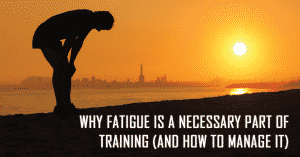In one of my previous articles, I outlined how you can incorporate shorter, more “fun-oriented” races into your schedule while still keeping the integrity of your training plan intact. If you read the article, you may have noticed that I made no mention of how to integrate marathons into your schedule – should you be thinking of including an easy marathon as either a long run or a fun run.
Believe it or not, it’s a question I receive often: “Would it be a good idea for me to run a marathon as a long run or ok to run for fun with my friends?”
I can understand the sentiment behind the question; the atmosphere at a marathon is electric and with all the likeminded runners around you, the miles can fly by. Unfortunately, if you want to maximize your chances of a PR at your next goal race, I don’t recommend running a marathon in training – either as a course-supported long run or for the atmosphere and camaraderie.
In addition to offering very little training benefit, the 26-mile distance is difficult to recover from (yes, even if you run easy) and can derail you from your optimal training routine for 10-14 days. Don’t take my word for it though, here is some of the science behind why you should avoid running a marathon as a long run or fun race:
Marathons are tough on the body
Muscles, tendons, ligaments, and almost every physiological system is challenged when running a marathon. It doesn’t matter if you’re a running easy, 26.2 miles is 26.2 miles and your body endures tremendous physical duress. Here is a list of some of the scientifically measured physiological systems that are most effected after running 26.2 miles:
Skeletal Muscle
Muscles soreness and fatigue are the most obvious case of damage caused by running the marathon distance. One scientific study conducted on the calf muscles of marathon runners concluded that both the “intensive training for, and the marathon itself, induce inflammation and muscle fiber necrosis that significantly impaired muscle power and durability”. Even if you you’re not feeling too beat up after running 26.2 miles, your muscles are undoubtedly weakened and need extensive recovery before returning to full training.
Cellular damage
Cellular damage post marathon is best measured by the presence and production of creatinine kinase (CK) – a marker that indicates damage to skeletal and myocardial tissue, and increased myoglobin levels in the blood stream.
One study concluded that CK damage persisted more than 7 days post marathon while another study discovered the presence of myoglobin in the bloodstream for 3-4 days post race. Both of these studies clearly indicate that the body needs rest post marathon to fully recover from the cellular damage caused during the race.
Immune system
Finally, studies have shown that the immune system is severely compromised after running the marathon distance, which increases the risk of contracting colds and the flu, especially if you intend to keep training hard in preparation for your goal race. Furthermore, a suppressed immune system is one of the major causes of overtraining.
While it’s obvious that running easy will slightly lessen the harmful effects of running a marathon, the research clearly indicates that the marathon induces significant muscle, cellular, and immune system damage for 3-14 days post run.
Little additional training benefit compared to a regular long run
Most runners training for the marathon are averaging anywhere from 8 to 11 minutes per mile on their long runs (training paces for a 3:30 to 5-hour marathon race finishing time). At a pace of 9 minutes per mile, a runner will take roughly 3 hours to finish a 20-mile run. While there is no doubt that a 20-mile run (or longer) can be a great confidence booster, from a training and physiological standpoint, they don’t make too much sense. Here’s why:
Most coaches and exercise scientists now know that your body doesn’t see a significant increase in training benefits after running for 3-hours. In fact, research suggests that the majority of physiological stimulus during long runs occurs between the 60 minute and 90 minute mark. This means that after running for 3 hours, aerobic benefits (capillary building, mitochondrial development, myoglobin levels) begin to actually stagnate or decline instead of improving. Therefore, doing a marathon as a long run builds about as much fitness as your normal 20-22 mile run.
While you might be ok with not building any additional fitness when doing your fun marathon long run, the downside is that the longer you run, the more you increase your risk of injury. While the extra 6 miles to go from 20 miles to the full marathon distance might not seem like much, muscle fatigue increases exponentially with every mile. During those last 4-6 miles, your form begins to breakdown, your major muscles become weaker, and overuse injuries begin to take their toll, even if you’re running easy. This risk of injury over these last few miles is more prevalent for beginner runners who’s aerobic capabilities (because of cross training and other activities), exceed their musculoskeletal readiness. Basically, there bodies aren’t ready to handle what their lungs can.
Finding the right balance
If you’re still determined to run the marathon as part of your training, either to enjoy the experience or to help a friend, you can always cut back on the total distance by either jumping in at 5-6 miles or stopping at 20-21 miles, when your normal long run would end.
If you’re pacing a friend, the start of a race is too congested to be of much assistance anyway. You’re better served jumping in at 6 miles, when the crowds begin to thin out, and being a little more fresh the last 6 miles to help give the pacing and motivation your running partner needs. (note: I don’t condone banditing races. I always suggest you pay the full race fee no matter how much of the course you will be running).
Conversely, if you’re running the marathon just to enjoy the experience or have some company, starting the marathon still allows you to appreciate all the pre-race energy and excitement. However, stepping off the course at 20-22 miles will allow you to recover faster and keep your training schedule on track. Since you’re not running for a time, and just want to enjoy the experience, not finishing shouldn’t be an issue.
As I have mentioned before, I understand that you’re not a professional runner and it’s important to find the balance between the optimal training schedule and getting the most enjoyment from your running. However, in this case, running a marathon as part of your training just doesn’t make sense. Get creative or think about the big picture and you’ll enjoy success at your goal race and keep training fun.
RunnersConnect Bonus
Download your FREE Long Run and Aerobic Pacing Calculator now.
Need help converting your race times to your optimal easy and long run pace? Download our FREE calculator and we’ll do the math for you.
A version of this post originally appeared at competitor.com





5 Responses
“This risk of injury over these last few miles is more prevalent for beginner runners who’s aerobic capabilities (because of cross training and other activities), exceed their musculoskeletal readiness. Basically, there bodies aren’t ready to handle what their lungs can.”
Along these lines, do you have any thoughts on the old walk-run method used specifically for people with this issue? The theory is that walk breaks allow the muscles, tendons, and ligaments to recover enough to avoid overstressing and injury on long runs, which would allow those with musculoskeletal hold ups to get in more mileage with less risk of injury and a faster recovery. On the other hand, I wonder if the walk breaks stray too far from the specificity of continuous running you are ultimately looking for in the race. I can see how, even with walk breaks, your muscles and ligaments are going to be subjected to fatigue and stress that would elicit a training effect. At the same time, is it going to transfer…any thoughts?
Hi TR,
You’re right, the walk breaks will lessen the stress on the structural system. However, they are not very specific to the demands of running the full distance and they don’t train your body how to burn fat as a fuel source to conserve glycogen. If you’re looking to run faster, this is a critical component. That’s why we suggest, shorter faster long runs buttressed against a medium-length steady run the day before the long run. More specific and reduces the stress on the structural system.
Hello Coach Jeff
In the run up to the ~88 km Comrades Marathon (www.comrades.com) which will be held 31 May 2015, I did two marathons and three ultras in approx 4 months. (Proven recipe for my past 4 Comrades Ultras)
Any comments of using marathons in this context as a long run in preparation?
Thanks
Pieter
South Africa
Hi Pieter, I am not sure I would make any drastic changes now, as all you are going to do is take away from your race. We have some information on how to train for an ultra marathon here for you to use in the future https://runnersconnect.net/ultra-training/train-for-ultra/ but for now, I would say to keep going as you are. If you have already been using marathons in your long runs, you are going to be fine, especially if you were running them as a long run to prepare for Comrades. This post was more intended for marathoners. Sorry we cannot help any more, but best of luck with the race!
Perhaps more information is in order : It was actually done in approx 3 months, with a total of just over 1000 km from 1 Jan to end April, which is probably the bare minimum for a sub 11h finish.